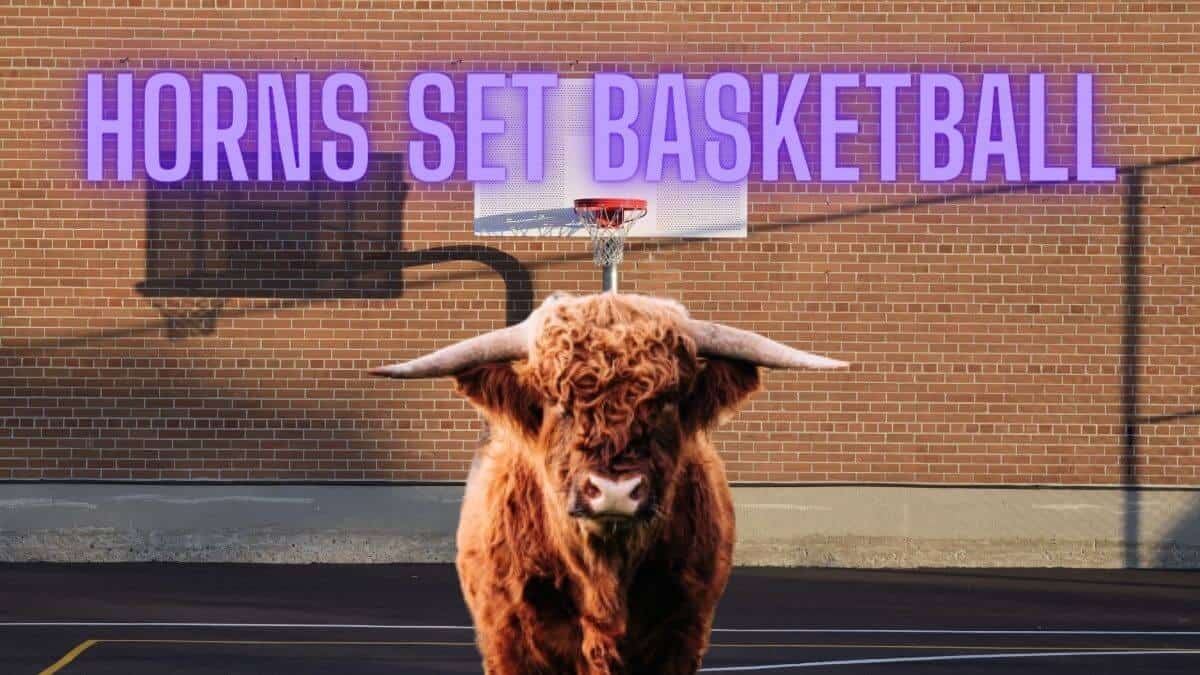The term, ‘horns set basketball’ is a reference to a popular strategy set in basketball coaching. The ‘horns’ basketball offense is one of the more widely known coaching play sets in basketball.
Former Duke coach Mike Krzyzewski (a.k.a. Coack K) is probably the most well known horns practitioner. Horns basketball featured prominently in Coach K’s playbook throughout his 40+ years coaching world class hoops.
What Does Horns Mean in Basketball?
The term ‘horns’ is a reference to the initial formation of the extensive ‘horns set’ of basketball plays. When we discus horns basketball, we’re looking at that large category of basketball offense where the plays all share that initial formation.
Typically, your point guard initiates a horns offense from the top of the formation. Your shooting guard and small forward will be nestled deep in the corners. The power forward and center are lined up at the top of the key, maybe a little higher. This is also sometimes referred to as an ‘A-set’ offense or a ‘V’ offense, for obvious reasons.
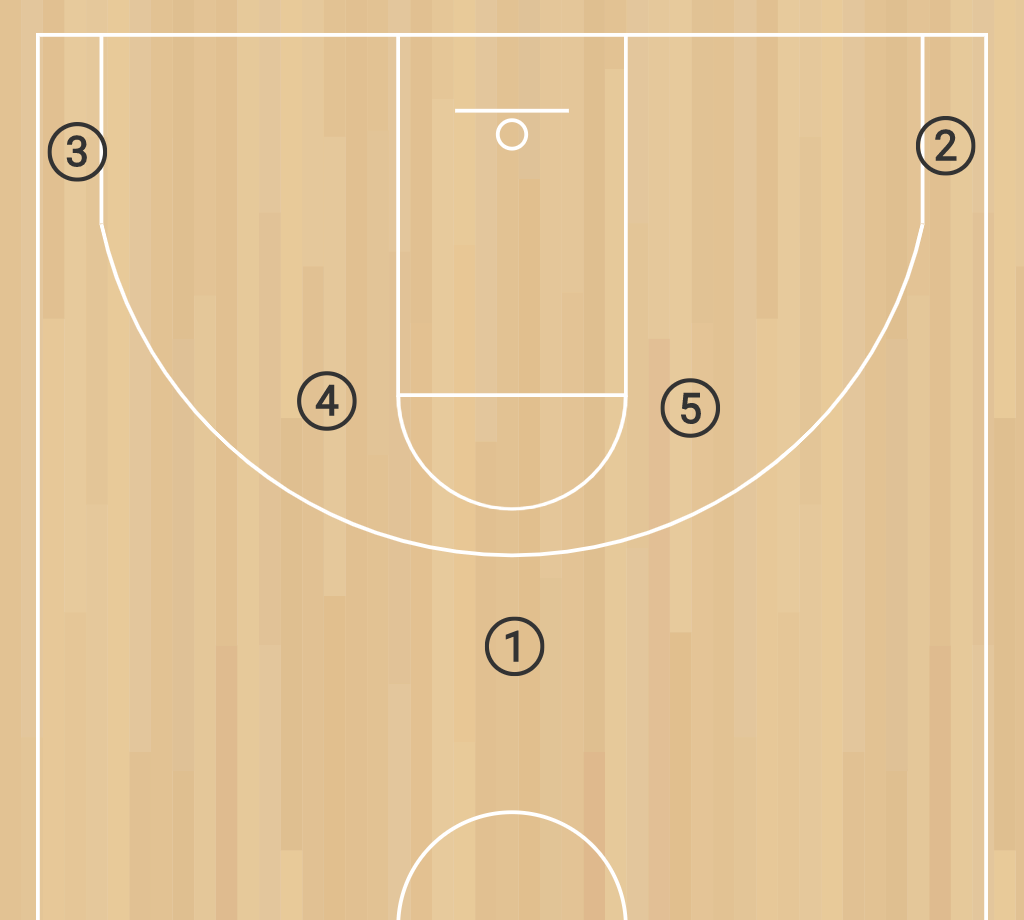
So the heart of a ‘horns set basketball’ maneuver is this simple v-shaped initial positioning. Your point guard tops the head of the bull and the horns stretch out to those corners. This almost feels like one of the first ideas you might stumble upon when organizing a basketball offense, staggering your players around the goal.
From this initial setting, a lot of your key options will involve screens at either elbow. Most horns set plays will start with your point guard moving in and taking advantage of screens from the 4 or 5 at the elbows. This generates space in the passing lane as 2 and 3 cut towards the basket.
But the devil is in the details. Don’t let the simplicity of this offense fool you. It can be extremely effective. You will recognize mutations of this offense at all levels of play. Horns set basketball is deployed in youth leagues, straight up to the NBA. It’s probably the most common and popular patterns in basketball and the play that follows from it is limitless.
How Horns Set Basketball Works
The screen is crucial to the horns offense. From the horn formation, the first decision your crew will approach is which direction to move the ball.
Typically, that decision will be facilitated by a screen. As your point guard shifts to one side of the court, one of those bigger players at the top of the key is tasked with getting in the way of the on-ball defender.
This pick will certainly beg for a pop or a roll. So those bigs are looking for their opening. A good shooter might jump out towards the arc, hoping to draw some defensive attention, or take a pass. That player at the arc can probably take the pop, or maybe hit the ole give and go.
Those corners, as they feel the passing lane open up, are looking to cut into the paint for a pass. Ideally, you would also set a screen closer to the basket to help them out. And a big should be there to run that screen.
See, when one of the bigs finds that initial screen, the opposite will often bolt into the paint. With a little luck, one player can clog things up and create enough confusion to get both of those cutters some extra space.
This is just a little sampler of the type of motions that can initiate from the horns offense. As I’ve mentioned, there are infinite possibilities that emerge from this initial offense formation. But I think it’s helpful to wrap your mind around these common motions so that you can begin to see the value of this set.
Horns Set Basketball Plays
Let’s run through a few plays to try and get the concept of horns set basketball to coalesce. There are a ton of plays that have been evolved out of this concept, but we’ll just take a look at some of the simpler motions. If you need more, you can find a fairly comprehensive set of plays over here.
Basic
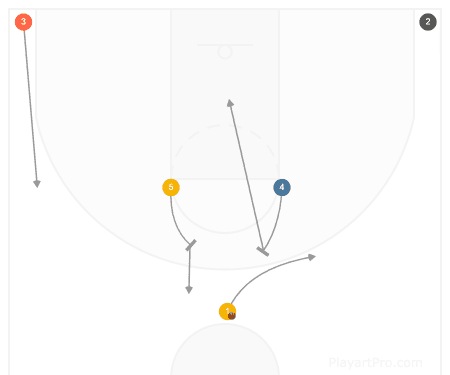
We’ll start with a basic form of the horns offense. This one is quite beautiful in its simplicity. It also illustrates the concept so neatly that it sets us up well to examine some more intricate examples.
Both the center and power forward set screens to either side of the peak of the arc. The point guard here selects the screen to the right from the power forward. The center then drops outside the arc and the power forward rolls for the basket. Meanwhile, the small forward is cutting towards mid-court.
You can see how this opens up several options. You might be able to nail the pick and roll with a pass to 4. Or you can try to go to 5 who then has a look at 4 right down the center, with an alternate look at 3 at the end of their cut.
This play reveals the true business-end of horns set basketball, that 4/5 screen.
Duke
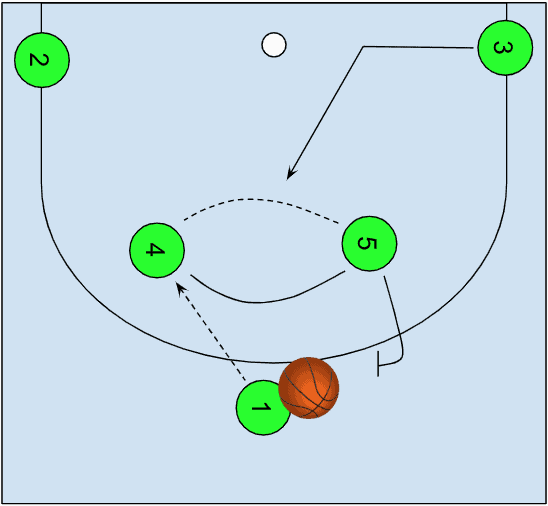
This is roughly how Coach K did it. This is kinda a version of the ‘horns 4-5 flare’. 1 passes in to 4 and 3 cuts in from the opposite wing while 5 sets a screen for 1 as a diversion. It’s not uncommon to actually take advantage of this screen and send the point guard down the lane or set them up for a pop.
This system works particularly well if you’ve got a young Zion Williamson at the 4. Drop the ball to Zion and distract the defense while he barrels down for the bucket.
This is something of a massive oversimplification of the entire playbook of one of the greatest basketball coaches in history. But you can see how this concept is echoed through the video below, demonstrating a range of Duke offensive plays against various defenses.
Barcelona Horns 1
This one is a little more intricate. It involves two distinct motions and a bunch of screens. Probably a little overkill, but quite interesting for the space it forces on a wing. As the 1 approaches, the 4 drops to set the screen and give them a little space to dribble off to the wing. The 4 then bolts over to give 5 some backup on a staggered screen for 3.
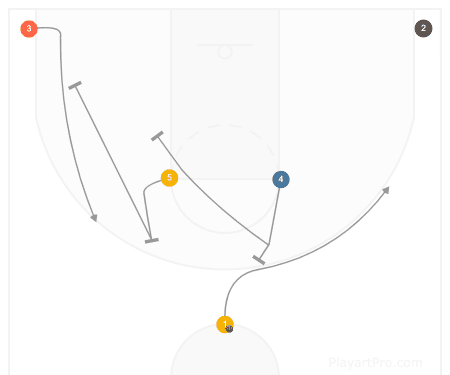
With 5 and 4 doubled up to hold off defenders, the 3 is almost assuredly open for a pass, jumping play across to the other side of the court and probably throwing the defense a little off balance. But the 2 has been sprinting across the court, taking advantage of the other side of that 4 and 5 combo screen to get in position for a pass from 3.
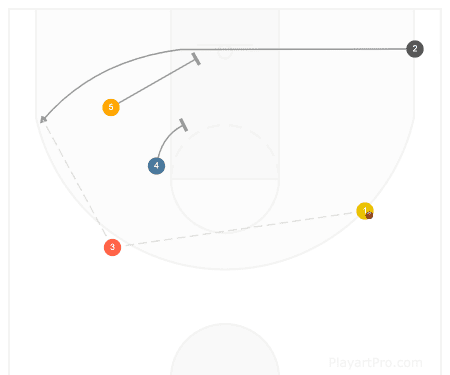
Benefits of Horns Set Basketball
Horns set basketball works well in transition. As you can imagine, it’s a pretty easy formation to jump into after you’ve taken control of the ball.
This points to the simplicity of the initial formation. There’s almost a natural gravity around the rim. The play that follows can become as intricate as your team can handle, but that natural pull of the initial positioning can also make this system easy to approach.
And the horns set naturally creates space on the floor. It initiates from a positioning that stretches the defense. Aggressive screening takes that stretched defense and further breaks it apart, opening up opportunities for your corners to cut in. And ideally, they’re cutting into traffic that’s organized to benefit your offense.
Defending Against Horns Set Basketball
It’s not exactly straightforward to defend against a set as diverse as the horns set. Sure, you could just say that you need to work on defensive principles in totality, but that’s a bit of a cop out.
Instead, let’s work from first principles a little. We know that the screen is a key feature of this set. Now, you could argue that the screen is a key feature of basketball in general, fine. But at least focusing on the screen a little is going to give us a place to start. Work on your switching, your hedging, try some double teams, or work through all of these strategies.
You can also take a look at your opposing bigs, that center and power forward on offense. Are either of these players shooting effectively? A shooting big will have a tendency to go for the pop. That is, it becomes strategically attractive to get that player out towards the arc.
And conversely, a poor shooter will be far more likely to jump into the paint when they’re freed up. Just knowing what to expect here can set your whole team to be ready for what this offense is throwing at you.
Down in the paint, be ready for those corner players to cut. Off-ball defenders need to see what’s going on and be ready to shut down those passing lanes. And as these players are pushed into the paint, they need to be ready to work well together to switch or work around each other on a dime. Be particularly cautious of allowing those offensive bigs to drop too deep into the paint, clog you up and setup the poster.
You might also consider trying to cut off the offense before they can even get into this formation. Horns set basketball is generally a half-court strategy. An effective full court press (a 1-2-2 for instance) can be particularly demoralizing here, restricting your opponent from even initiating their attack strategy.
Of course, there’s an entire class of horns set strategies designed to initiate from transition as well. so expect that, if you apply full-court defensive pressure, your opponent may have a plan for that.
The History of Horns Set Basketball
Part of the beauty of sport in general is the overwhelming intricacy. From a simple goal (moving a ball into a basket in our case) emerge infinite choices.
It’s a natural tendency to try and manage that complexity through organization and classification. As you develop and apply a strategy, you begin to discover advantages. You can then practice and refine that strategy. Pretty soon, your team begins to move as a unit, your players anticipating each others movements. Decision-making becomes more fluid. A system of play evolves.
That system can revolve around any type of pattern that evolves in the game. In team sports, (basketball included) systems will often emerge from player positioning. And this is where horns set basketball originated. Given 5 players approaching the basket, it’s only natural to settle into a position where your placers are evenly spaced around the goal.
And indeed, horns set basketball seems to have emerged quite naturally. I’ve searched high and low and can’t find any reliable reference to its first application. Considering the crazy number of plays it encompasses, it’s a little silly to try and credit anyone with inventing the concept anyway. However, some of these specific plays can be attributed to some well known coaches. And there are a bunch of coaches who are recognized as practicing horns set basketball.
Conclusion
Horns set basketball can form the basis of an effective offensive strategy at any level of basketball play. As the first offensive basketball strategy you work with, you should quickly find the points that make it worthwhile.
But this offense has also been openly favored by some of the greats. The Pacers’ Rick Carlisle, Michigan’s Tom Izzo, and even Duke’s infamous coach K, are all proponents of the horns set. Their motions are all valuable studies and easy to find on Youtube.
Give it a shot. And let me know if you find some success or run into any questions.
